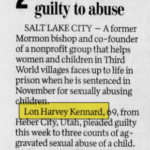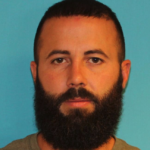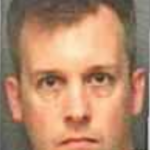 LDS positions: Other leader,
LDS positions: Other leader,  During alleged crime: Other leader,
During alleged crime: Other leader, - LDS mission:
 unknown
unknown  Alleged:
1 victim,
Alleged:
1 victim,  Criminal case(s): Never charged, Not convicted,
Criminal case(s): Never charged, Not convicted,  Civil case(s): Lawsuit v. LDS church,
Civil case(s): Lawsuit v. LDS church,  Alleged failure to report
Alleged failure to report Alleged church actions: Excommunicated, Ward official accused of failure to report,
Alleged church actions: Excommunicated, Ward official accused of failure to report,  updated Nov 23, 2025 - request update | add info
updated Nov 23, 2025 - request update | add info
FLOODLIT is seeking more information on this case.
In 2008, a sexual abuse survivor unsuccessfully attempted to sue the Mormon church in the New South Wales (NSW) Supreme Court in Australia.
She was seeking an extension of the statute of limitations in order to be able to sue the LDS church.
She alleged that the church knew about the abuse but kept it secret and didn’t tell police.
The alleged abuser was her stepfather, an elder in a Queensland LDS ward.
The alleged abuse took place between 1986 and 1988 in Queensland, and in 1989 after the family moved to southern NSW.
Have any info on this or other Mormon sex abuse cases? Contact us.
As an independent newsroom, FLOODLIT relies on your generous support to make thousands of reports of sexual abuse in the Mormon church available. If you find our work helpful, please consider donating! Thank you so much for helping us shine a light.
Sources
-
1. Woman fails to sue Mormons over 'abuse'
A woman who claims she was sexually abused by her Mormon stepfather 20 years ago has failed in her bid to sue the church over the abuse.
The woman was seeking an extension of the statute of limitations in the NSW Supreme Court so she could sue the church, but the court on Thursday dismissed her attempt and ordered she pay its costs.
The 36-year-old woman, who cannot be named for legal reasons, says she was abused by her stepfather, an elder in a Queensland chapter of the Church of Jesus Christ of Latter-Day Saints, between 1986 and 1988.
She says the church failed in its duty of care by not telling police after her mother reported the abuse to the church in Ipswich, south of Brisbane, and her stepfather was expelled after an internal review.
The woman alleges the church's failure to alert authorities resulted in a diagnosis of post-traumatic stress disorder in 2002 and an "incapacity for employment."
But Justice Carolyn Simpson said too much time had expired to grant an extension of the statute of limitations in order to bring a claim against the church.
"I have concluded that the plaintiff's case must fail," Justice Simpson said in her judgment.
She said the plaintiff had all facts available to her by 28 October, 2004, meaning "the time to bring action (was up until) 28 October, 2005 - but no later."
"Action is not brought by filing a summons seeking an extension of time in which to do so. Even as at the present time, the plaintiff still has not brought an action."
Justice Simpson excluded any costs associated with "excessive photocopying" and was critical of the "astronomical costs" incurred by both parties who were forced to wade through thousands of pages of documents submitted by the church.
She also excluded costs associated with the preparation and presentation of an "entirely misconceived" argument by the church that Australia's Constitution had any bearing on the proceeding.
"On no view could it be said that a law overriding the confidentiality of religious confession is a law prohibiting the free exercise of religion," she said in the judgement.
"If that were so, religions (or as the argument was put, churches) would be free to make their own rules."
Documents
Have docs or info? Add information
Criminal case documents
We believe this person was never criminally charged, so no related criminal case documents exist. If you have information that suggests otherwise, please contact us.
Civil case documents
Floodlit does not have a copy of a related civil complaint. Please check back soon or contact us to request that we look for one.Other documents
Floodlit does not have a copy of any other related documents. Please check back soon or contact us to request that we look for some.Add information
If someone you know was harmed by the person listed on this page, or if you would like us to add or correct any information, please fill out the form below. We will keep you anonymous. You can also contact us directly.

 Alleged crime country:
Alleged crime country:



